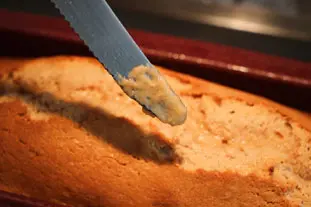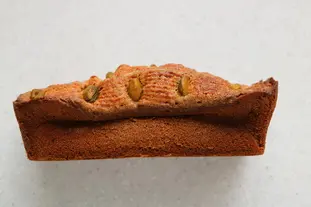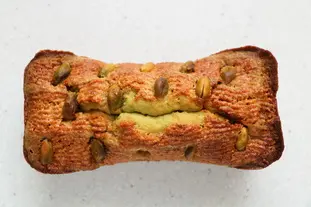This site uses only a few technical cookies necessary for its operation. By continuing to browse, you accept their use.
To find out more...
To find out more...
Unmoulding cakes while hot

When you make a cake, pound cake or whatever (what bakers call a "travel cake" because it's easy to carry around) you've most likely made a batter, either by hand or in a food processor, which you then pour into a buttered pan.
It's a classic, and I've already talked to you about 2 or 3 tips on cold dough, or how to have a nice opening on the top etc.
That was all about the pre-bake period, but let's look at the post-bake period.
It's a classic, and I've already talked to you about 2 or 3 tips on cold dough, or how to have a nice opening on the top etc.
That was all about the pre-bake period, but let's look at the post-bake period.
39 K 4.6/5 (25 reviews)
Keywords for this post:BakingCookingCakeUnmouldingTipsLast modified on: February 6th 2021
Unmoulding cakes while hot
First of all, the control of the baking process
First of all, the most important thing is the control of the baking process, let's be clear: a baking time indicated for a cake in a recipe is most of the time very approximate. This baking time depends on your oven, the temperature of the oven, the oven itself, the temperature of the batter, the type of pan etc. etc. The only thing missing is the age of the captain...So the only good way to check if a cake is cooked properly is to stick a knife in the middle, if it comes out dry, the cake is cooked, and if not (trace of raw dough) it needs more time.

Not enough cooked

Enough cooked
The unmoulding
Imagine that it is well cooked => you turn off the oven, put on the gloves and take the mould out of the oven to put it on a surface that does not fear heat.And then you wait for it to cool down.
Well no, that would be a mistake, if you do that, the cake will cool in its tin, and badly or rather unevenly, the tin acting as a heat preserver. Worse, it will form on the edges of the mold some kind of steam bubbles that will deform your cake, which gives this kind of defect:


Note that the defect will be accentuated with metal or glass molds, which conduct heat better, and a little mitigated with those made of silicone or paper.
What to do?
It's quite simple, you have to unmould your hot cake, very hot even, and put it immediately on a grid.The easiest way to do this is :
- Once the mold is removed from the oven, wait 1 or 2 minutes that the cake begins to cool and shrink a little, it facilitates the removal
- Keep the gloves on, tip the pan with one hand, put your other hand underneath and shake lightly until the cake falls into your hand
- Turn it over and put it on a rack to cool down in a quiet place
- Bonus: Put the pan to soak right away, to make cleaning easier, and leave the oven door off so that it cools down faster (and the internal fan stops)

It's all very simple, but this way your beautiful cake will cool down faster, and above all without warping.
In summary: You must remove a cake from the oven as soon as it is baked, otherwise it will warp.
Lasts posts
Butter vs. grease
We often read in a recipe where a pastry is put into a mould that, just before pouring, the mould should be buttered or greased. But what's the difference between these 2 terms?December 1st 20259755
Getting out of the fridge early
Very often when you're cooking, you need to take food or preparations out of the fridge, to use them in the recipe in progress. There's nothing tricky about this: you just take them out of the fridge and use them, usually immediately, in the recipe. But is this really a good method?November 24th 20251,1115
Who's making the croissants?
When you look at a bakery from the outside, you naturally think that in the bakery, the bakers make the bread, and in the laboratory, the pastry chefs make the cakes. It's very often like that, with each of these professions having quite different ways of working, but sometimes there's also one...November 23th 20251,002
Oven height
When we put a dish or cake in the oven, we naturally tend to put it on the middle shelf, and that's what we usually do. But in some cases, this position and height can be a little tricky, so let's find out why.October 8th 20252,7375
The importance of sieving
In recipes that use a fine powder (flour, powdered sugar, etc.), you'll often see the advice to sift before using it. To sift is to pass the powder in question through a sieve (a very fine strainer) before incorporating it into your recipe. It's often advice, but is it really useful?September 3rd 20257,5293
Other pages you may also like
Candied fruits: don't get ripped off
Do you like candied fruit? You might like to nibble a handful or add it to a recipe, like a classic fruit cake or delicious Italian specialities like panettone or sicilian epiphany pie.June 21th 201767 K 24.2
A few tips for effective kneading at home
When you have to knead dough for bread or some other recipe, you may well use a food processor or the type of machine known as a stand mixer. The best-known brands are Kenwood and KitchenAid. They are useful tools, but here are a few tips to help you get the best out of them.June 23th 2021284 K 23.8
Tranché, dissociated, failed, in short... missed!
When preparing a sauce or a cream, there's always a (small) risk that the creamy preparation you're working on will suddenly separate into two parts of different textures: a liquid part, for example, and a more or less solid part, or even become lumpy. It's terribly frustrating, but we'll see...June 19th 202313 K5
No need to boil gelatin
Gelatin is a magical ingredient for making light, creamy, structured desserts, yet it's often misused in the kitchen. A common mistake in some recipes is the idea that it needs to be boiled for it to work properly, but this is a mistake indeed: gelatin melts at a much lower temperature, around...November 21th 20248,2695
The beautiful story of the croissants
As you may have already noticed, cooking, baking and pastry-making are full of stories or legends, usually very romantic, about this or that product or recipe. This is often the case for named recipes, for example tarte tatin, peach melba, paris-brest and many others, but it also applies to very...October 10th 201819 K5
Post a comment or question
Follow this page
If you are interested in this page, you can "follow" it, by entering your email address here. You will then receive a notification immediately each time the page is modified or a new comment is added. Please note that you will need to confirm this following.
Note: We'll never share your e-mail address with anyone else.
Alternatively: you can subscribe to the mailing list of cooling-ez.com , you will receive a e-mail for each new recipe published on the site.









